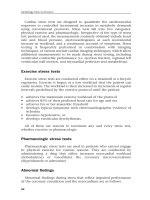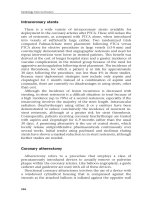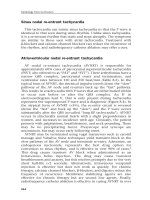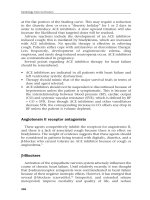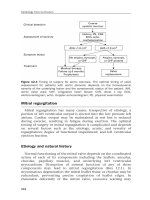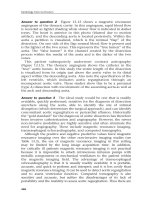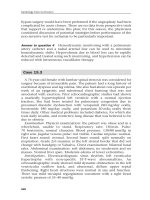Cengage advantage books cultural anthropology a problem based approach 5th edition richard robbins test bank
Bạn đang xem bản rút gọn của tài liệu. Xem và tải ngay bản đầy đủ của tài liệu tại đây (142.01 KB, 9 trang )
Chapter 1: Culture and Meaning
Test Bank
Multiple Choice Questions
1.
The most basic question cultural anthropology explores is: Why
a)
b)
c)
d)
do civilizations rise and fall?
is there such variety in human beliefs?
are humans so diverse biologically?
are some cultures superior to others?
Answer: b [p. 4]
2.
An example of how a classroom’s design serves to discipline would be
a)
b)
c)
d)
the chairs.
the distribution of people in space.
clocks.
all of the above
Answer: d [pp. 2-3]
3.
People differ in how they view the world because
a)
b)
c)
d)
geographical locations differ.
genotypic composition differs.
families differ.
cultures differ.
Answer: d [p. 4]
4.
The common life events that all people experience differ mainly in the
a)
b)
c)
d)
language used to explain these events.
meanings people give to these events.
geographical location in which these events occur.
way certain families explain and experience these events.
Answer: b [p. 6]
1
5.
According to Clifford Geertz, people impose meaning on their actions and
experiences because:
a)
b)
c)
d)
it is a biological imperative of the human brain.
people's actions and experiences are continually changing.
without these meanings the world would seem composed of chaotic actions.
without these meanings outsiders are excluded from understanding these
experiences.
Answer: c [p. 6]
6.
The ethnocentric fallacy is the notion that our beliefs are
a)
b)
c)
d)
right while those of other people are wrong.
shared by all other peoples.
influenced by our language.
influenced by those outside our belief system.
Answer: a [p. 8]
7.
In dealing with death, the Dani of New Guinea
a)
b)
c)
d)
require a close female relative of the deceased to cut off part of a finger.
require widows to shave their heads.
are expected to restrain their grief.
cremate widows at their husband's funeral.
Answer: a [p. 5]
8.
How can human differences and similarities best be treated to avoid both the
ethnographic and relativistic fallacy?
a) By highlighting the differences to show the myriad ways humans can construct
their universes
b) Treating them as a text filled with symbols that need to be deciphered
c) By highlighting the similarities to show the ways in which all humans are alike
d) By treating them as obstacles to be overcome in the creation of a universal,
homogeneous culture
Answer: b [p. 22]
2
9.
A specific belief or behavior can best be understood
a)
b)
c)
d)
in relation to other cultures with similar beliefs and behaviors.
by finding a similar belief or behavior in your own culture.
by dissecting and analyzing its structure and meaning.
in relation to the cultural systems of meaning which it is embedded.
Answer: d [p. 9]
10.
To understand the practice of virginity testing in Turkey, one must first
understand
a) how Turkish villagers understand the reproductive process.
b) the role of in-laws in the family structure.
c) the history of the Ottoman Empire.
d) the role of women in the Turkish family.
Answer: a [p. 10]
11.
What does the “seed and soil” metaphor describe in Turkish village society?
a) Agriculture
b) Reproduction
c) Horticulture
d) How to start a garden
Answer: b [p. 10]
12.
Nancy Scheper-Hughes argues that anthropology must
a) remove all traces of political judgment from research.
b) be critically grounded and morally engaged.
c) recognize the interests of those agencies that fund anthropological research.
d) uphold the idea of moral relativism.
Answer: b [p. 13]
13.
What makes cultural anthropology different from other forms of social science
research?
a)
b)
c)
d)
The use of surveys
A focus on communities
A focus on qualitative research
The use of fieldwork and participant observation
Answer: d [p. 15]
3
14.
Americans believe that success is the result of
a) hard work.
b) sacrifice.
c) self-denial.
d) All of the above
Answer: d [p. 26]
15.
Claude Levi-Strauss believed that the process of immersing themselves in the
world of others causes anthropologists to become
a)
b)
c)
d)
aware of the difficulties in understanding their own beliefs.
marginal men or women.
completely absorbed by the cultural practices they observe.
completely removed from the cultural practices they observe.
Answer: b [p. 20]
16.
______________ holds that no behavior or belief can be judged to be odd or
wrong simply because it is different from one’s own.
a) Chauvinism
b) Relativism
c) Participant observation
d) Ethnocentrism
Answer: b [p. 9]
17.
In participant observation,
a)
b)
c)
d)
a researcher observes the actions of informants.
the observer actively participates in the lives of his or her informants.
the observer seeks to change the cultural practices of his or her informants.
the observer participates in a situation by removing his/herself from all daily
actions.
Answer: a [p. 15]
4
18.
What is the purpose of using the ethnographic method as a research approach?
a)
b)
c)
d)
To prove one's own view of the world to others
To question the beliefs of the society being studied
To ask embarrassing questions about other cultures
To better understand the meanings people ascribe to their lives
Answer: d [p. 15]
19.
What personal experience allowed Renato Rosaldo to better understand the
behavior of the Philippine Ilongots?
a)
b)
c)
d)
His ability to achieve fluency in their language
His loss of faith in his religion
The accidental death of his wife
The paralysis of his legs
Answer: c [p. 25]
20.
The cockfight is important to Balinese men because it
a)
b)
c)
d)
reveals the violent and aggressive nature of Balinese culture.
reveals the economic and political natures of the Balinese.
is a story the Balinese tell themselves about themselves.
reveals to others what the Balinese culture defines as important.
Answer: c [p. 24]
21.
In reading American football as a cultural text, it seems that Americans feel about
football the same way they feel about
a)
b)
c)
d)
a corporate boardroom.
war.
marriage.
death.
Answer: b [p. 25]
22.
American football best represents which American ideal?
a)
b)
c)
d)
Relations with others as these are supposed to work
Family as it is supposed to work
Success as it is supposed to work
Games as it is supposed to work
Answer: c [pp. 26-27]
5
23.
Why is ethnocentrism intellectually weak?
a)
b)
c)
d)
It creates unbiased intercultural understandings.
It makes any kind of intercultural understanding impossible.
It assumes other cultures to be superior to one's own culture.
It assumes the inferiority of certain cultures.
Answer: b [p. 9]
24.
Soccer may be international, but deciding the outcome of games is not. For
example, how did the Gahuku-Gama of New Guinea decide when a game was
finished?
a) When one team achieved a certain number of goals
b) When the sun set
c) When a committee of elders decided the game was tied
d) When one team was three goals ahead
Answer: c [p. 26]
25.
By examining the “Happy Meal” advertised by one fast-food chain,
anthropologists can
a) draw broad conclusions about American tastes in food.
b) deduce how much multinational firms spend on food.
c) provide insights into demographic and ecological patterns, industrial and
agricultural history, and gender roles.
d) None of the above
Answer: c [pp. 27-28]
True/False Questions
1. Cultural relativism holds that no behavior can be judged odd or wrong.
Answer: T [p. 9]
2. People participate in different realities which helps give rise to differences in cultures.
Answer: T [p. 6]
6
3. An American’s opinion that a man in ceremonial attire looks odd is an ethnocentric
fallacy.
Answer: T [p. 8]
4. We should understand and examine our own cultural practices because this will enable
us to prove our cultural superiority.
Answer: F [pp. 8-10]
5. Human attitudes toward death are generally similar.
Answer: F [p. 5]
6. Sati is the practice of a widow burning herself on her husband’s funeral pyre in India.
Answer: T [p. 14]
7. A warrior in Papua New Guinea who has a nose ornament can readily understand
piercing-for-beauty in the Western world.
Answer: F [p. 8]
8. Embarrassing moments in the field may help anthropologists better understand a
culture.
Answer: T [p. 16]
9. When an anthropologist refers to the text of a culture he or she is referring to the
culture's written system of language.
Answer: F [p. 22]
10. The Gahuku-Gama of the Highlands of New Guinea play soccer to the death.
Answer: F [p. 26]
11. American football teams can be viewed as representations of business corporations.
Answer: T [p. 27]
12. Anthropologists only study cultures different from their own.
Answer: F [p. 27]
7
13. Until two centuries ago, European physicians practiced "medicinal cannibalism."
Answer: T [p. 11]
14. The Wari people of South America practiced cannibalism due to food shortages.
Answer: F [p. 12]
15. After hearing the detailed horror stories of death, disappearance, and torture in
Guatemala, anthropologist Linda Green began having nighttime hysteria and
nightmares.
Answer: T [p. 19]
Short Answer Questions
1. How do Turkish villager views of conception and the reproductive process compare to
a seed and soil when growing a plant? [p. 10]
2. The Balinese cockfight reveals the daily struggle for what? [p. 22]
3. How are the Balinese cockfight and American football similar? [pp. 25-26]
4. What benefit does the objectification of our own culture in the same way we objectify
the beliefs and behaviors of others yield to us? [p. 9]
5. How can a simple thing such as a “Happy Meal” communicate information about
American society? [pp. 27-28]
6. What is the difference between general American attitudes toward death and those of
people in Southern Italy? [p. 5]
7. What is one of the major characteristics of human beings that distinguish them from
other species? [pp. 4-5]
8. Why does Clifford Geertz say that human beings are "incomplete or unfinished
animals"? [p. 6]
9. What is the ethnocentric dilemma? What is the relativistic dilemma? [pp. 8-9]
10. What is one solution to the dilemma of choosing between relativism and
ethnocentrism? [pp. 8-9]
11. In what way is culture like a "text"? [p. 22]
8
12. What kind of statements does the cockfight make to Balinese males about status?
[pp. 22-24]
13. What does an American football game tell observers about American gender norms?
[p. 26]
14. What does an analysis of professional wrestling tell us about ethnic and race relations
in America? [pp. 26-27]
15. What are some of the meanings about the American idea of "success" contained in a
football game? [p. 26]
Essay Questions
1. Describe cultural ethnocentrism and cultural relativism. What are the main
inadequacies of each for understanding other cultures? [pp. 8-9]
2. Why is it difficult for an anthropologist to judge a society based solely on the concepts
of relativism or ethnocentrism? Use examples from the Abelam tribe of New Guinea,
Turkish villagers, and the Indian practice of sati. [pp. 11-16]
3. Justify the practice of sati through a purely ethnocentric view. Then do the same
through a relativistic view. [pp. 14-15]
4. Describe the ethnographic method and what it allows one to accomplish. [p. 15]
5. What did Michael Kearney's experience with witchcraft in Santa Catarina teach him
about his own belief system? What happened to his view of the Ixtepejanos’ world
view after this incident? [p. 17]
6. Describe some common symbols in American football and explain their meaning. [p.
26]
7. The make-up of football and “Happy Meals” reveals various meanings in U.S. culture.
Analyze one other activity or item from our everyday American lifestyle and explain
how social norms and practices are expressed through hidden meanings within this
activity. [p. 29]
8. Barbie and Hot Wheels are gender-specific gifts found in fast food “Happy Meals.”
Give examples of other gender specific gifts. What are the consequences if the girls
play with the boys’ specific toys, and the boys playing with the girls’ specific toys?
[pp. 27-28]
9


